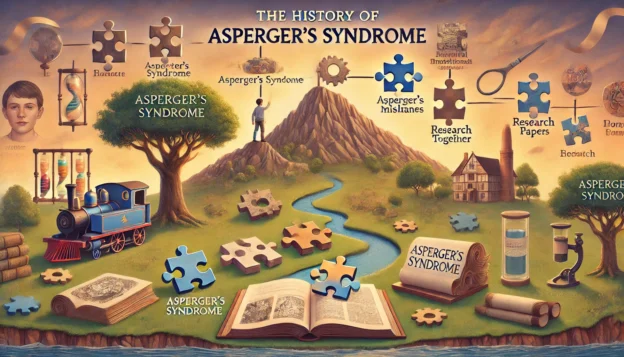Asperger’s Syndrome, first identified by Dr. Hans Asperger in 1944, describes individuals with normal intelligence and language development but significant social and communication challenges. British psychiatrist Dr. Lorna Wing brought Asperger’s work to global attention in the 1980s, emphasizing the unique profiles within the autism spectrum. Asperger’s Syndrome was officially recognized in diagnostic manuals in the 1990s but was merged into Autism Spectrum Disorder (ASD) in the DSM-5 in 2013. This consolidation has been controversial, with critics arguing it overlooks the specific needs of those with Asperger’s. Despite this, the legacy of Asperger and Wing continues to influence the understanding and support of autism spectrum conditions.
Introduction
Asperger’s Syndrome is a developmental disorder that was recognized as a distinct condition within the autism spectrum. Its history involves significant contributions from several researchers, most notably Dr. Hans Asperger, after whom the condition is named, and Dr. Lorna Wing, who played a pivotal role in bringing the condition to global attention.
Hans Asperger’s Pioneering Work
The history of Asperger’s Syndrome begins with Dr. Hans Asperger, an Austrian paediatrician who first identified the condition in 1944. Asperger described a group of children who exhibited normal intelligence and language development but displayed marked deficiencies in social and communication skills, narrow interests, and repetitive behaviours. These children had difficulty forming friendships, understanding social cues, and empathizing with others. Asperger referred to them as having “autistic psychopathy,” a term that would later evolve into Asperger’s Syndrome.
Asperger’s work was largely overlooked in the English-speaking world until the 1980s. His observations were published in German during World War II, a period when international scientific communication was significantly disrupted.
Lorna Wing’s Contributions
Dr. Lorna Wing, a British psychiatrist, is often credited with bringing Asperger’s work to the forefront of autism research. In the early 1980s, Wing translated Asperger’s original paper and introduced his findings to the English-speaking medical community. Her landmark paper, published in 1981, highlighted the unique profile of behaviours and skills that Asperger described, emphasizing the need for a separate diagnostic category within the autism spectrum.
Wing’s work was instrumental in redefining the understanding of autism as a spectrum disorder. She proposed the concept of the “autistic continuum” or spectrum, which recognized that autism could present in a wide variety of forms and severities, from individuals with severe impairments to those with high-functioning autism, including Asperger’s Syndrome. This perspective significantly influenced the diagnostic criteria and treatment approaches for autism.
Diagnostic Recognition and Evolution
The recognition of Asperger’s Syndrome as a distinct diagnostic category was solidified in the 1990s. The condition was included in the International Classification of Diseases (ICD-10) by the World Health Organization (WHO) in 1992 and the Diagnostic and Statistical Manual of Mental Disorders (DSM-IV) by the American Psychiatric Association (APA) in 1994. Both manuals described Asperger’s Syndrome as part of the broader autism spectrum, characterized by significant difficulties in social interaction and nonverbal communication, alongside restricted and repetitive patterns of behavior and interests.
DSM-5 and the Consolidation of Autism Spectrum Disorders
In 2013, the publication of the DSM-5 brought significant changes to the classification of autism-related conditions. The DSM-5 consolidated Asperger’s Syndrome, Pervasive Developmental Disorder-Not Otherwise Specified (PDD-NOS), and other related diagnoses into a single category: Autism Spectrum Disorder (ASD). This decision was based on research indicating that these conditions shared more similarities than differences and that a single-spectrum diagnosis would better reflect the range of symptoms and severities.
While this change aimed to improve diagnostic consistency and reflect the continuum of autism manifestations, it also sparked controversy. Critics, including some researchers and advocacy groups, argued that combining these diagnoses might overlook the unique needs and challenges of individuals who previously had specific diagnoses like Asperger’s Syndrome.
Legacy and Ongoing Debates
Despite the DSM-5 changes, Asperger’s Syndrome remains a widely recognized and used term, especially in clinical and educational contexts. The legacy of Hans Asperger and Lorna Wing continues to influence how autism is understood and approached. Wing’s work, in particular, has had a lasting impact on the field of developmental disorders, shaping the concept of the autism spectrum and advocating for the recognition of diverse presentations of autism.
The ongoing debates about the classification and terminology of autism highlight the complexities of diagnosing and supporting individuals with autism spectrum conditions. The contributions of researchers like Asperger and Wing underscore the importance of a nuanced understanding of these conditions to provide appropriate and effective interventions.
References
- Wing, L. (1981). Asperger’s syndrome: a clinical account. Psychological Medicine, 11(1), 115-129.
- Asperger, H. (1944). Die “Autistischen Psychopathen” im Kindesalter. Archiv fur Psychiatrie und Nervenkrankheiten, 117, 76-136.
- American Psychiatric Association. (1994). Diagnostic and Statistical Manual of Mental Disorders (4th ed.). Washington, DC.
- World Health Organization. (1992). International Classification of Diseases (10th ed.). Geneva, Switzerland.
- American Psychiatric Association. (2013). Diagnostic and Statistical Manual of Mental Disorders (5th ed.). Washington, DC.
